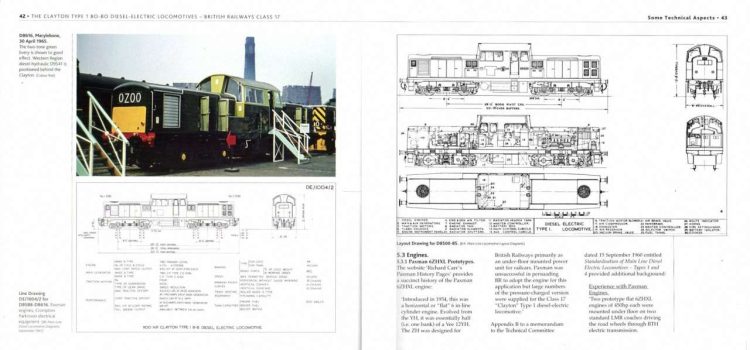Published in May 2021, this book from publishers Pen & Sword provides a detailed history of the Clayton Type 1s as part of their “Locomotive Portfolios, Diesel & Electric” series.
Written by Anthony P. Sayer, the landscape format hardback book measures around 25.8 cm x 24.6 cm, is a massive 376 pages long and has over 280 colour and black and white photographs, diagrams, and illustrations. It has a published price of £40 although Pen & Sword currently has it on offer at £28.00, and at the time of writing it can be obtained from Amazon for around the same price. The quality of the finished product is superb.
The Claytons were originally conceived as the British Railways standard Type 1 diesel-electric locomotive, superseding other Type 1 classes delivered as part of BR's Pilot Scheme. With 25 chapters, this book could be said to be an encyclopaedia of the Claytons, as it has a comprehensive history of every member of the class.
The chapter headings give some idea of the depth of detail. Starting with Chapter 1, there is BR First-Generation Type 1s, followed by: The Route to Standardisation; The ‘Standard' Diesel-Electric Type 1; Order Placement; The Next 100 Type 1's: D8617-D8716 or Back to Plan A/; Some Technical Aspects; Appearance Design and Styling; Delivery and Acceptance Testing; Allocations; Overhaul and Repairs.
Chapter 10 continues with Locomotive Histories; followed by Performance and Service Problems; Engines and Associated Equipment; Other Performance and Service Issues; Accident and Fire Damage; Operations High-Level Summary; Detail Differences; Liveries; Storage and Withdrawal; Storage Locations: Depots and Yards; Disposal: The Private Yards (1968-71).
Chapter 20 continues with Disposal: St. Rollox Works; followed by Disposal: The Private Yards Return (1975-76); Post-Withdrawal Use; Industrial Service; Preservation; and finally, Chapter 25 includes Concluding Remarks.
This book gives an excellent account, not just of this particular class, but of how BR reached policy decisions involving the expenditure of millions of pounds in the early modernisation era. As well as general technical and historical coverage, there is detail about the history of each member of the class. The author has also included a detailed account of the process of the class's design, procurement and delivery, and their service lives and demise.
The author has clearly carried out extensive research, and this becomes clear from the amount of detail extracted from original source material and reports, minutes of meetings, and other information available in archives and records. The amount of work he has done in drawing all the information together and then putting it into order must have been enormous.
There are detailed listings for each class member, including allocation history, liveries, detail differences, and operations. With a book of this size, a sensible choice of the chapter breakdown is needed, and the author has done well to achieve this.
Extracts from meeting minutes soon make it clear why Class 17's had a reputation for poor reliability. But it becomes obvious that someone in authority should have taken the decision to curtail the orders long before the delivery of the class was completed.
This book provides excellent in-depth detail of a design that was let down badly by mechanical shortcomings. It was unfortunate that the kind of work for which the Class 17s were intended was fast disappearing, and it calls into question the way British Railways ordered so many.
Although the class was confined to Scotland and northern England, a member of the class did venture south as shown with this photo below of D8616 on display at an exhibition at Marylebone. The illustrations on the pages also show the extent of detail that the author has sourced for the book.

The pages below show the extent of detail included for each class member. They also highlight a couple of minor niggles with the book. One is the lack of separators in dates, such as 030363 instead of 3/3/63 for 3rd March 1963. The other is the use of various text colours, including red, blue, violet, and green, without any explanation for their use.
Although the right-hand page below shows Class 17s doing what there were designed for, the left-hand photos confirm that they were occasionally to be found on passenger work, but not often to be found double-heading steam locomotives as in the lower picture.
In summary, this volume is probably the most comprehensive account of the class 17s that one could wish for. The large selection of images provide a record of the daily lives of each member of the class, both in traffic and in various states of disposal. Although expensive, it is excellent value for money and a must-have for anyone who wants to know the history of the Claytons. Highly recommended.
The book is available to purchase from Amazon and from Pen & Sword.
RailAdvent would like to thank Pen & Sword for providing RailAdvent with a copy of the book for review.
Thank you for your very kind review. For information, the text colour coding is explained on page 77 of the book at the start of Chapter 10 “Locomotive Histories”.